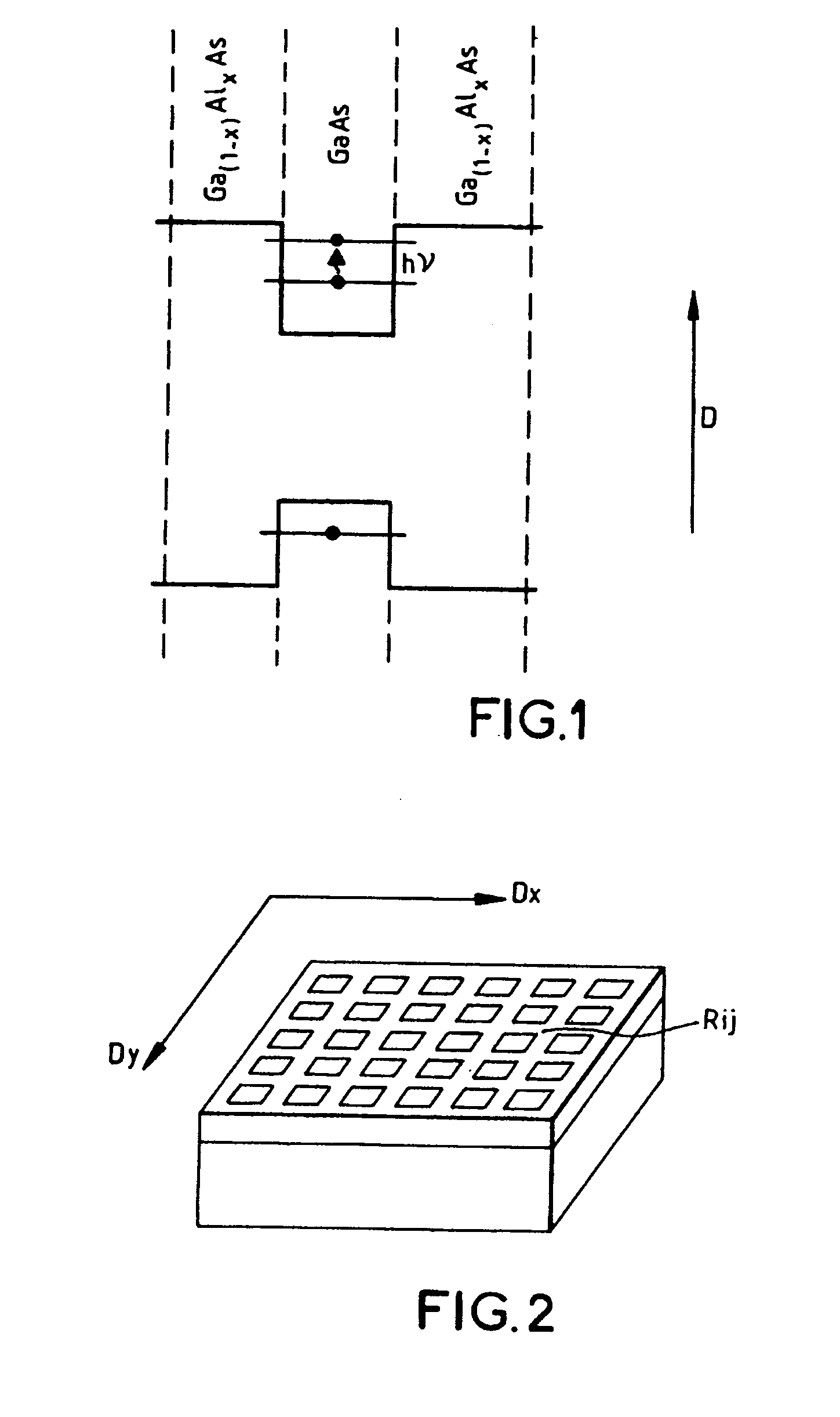Amorphous optical coupling structure for an electromagnetic wave detector and associated detector
a detector and optical coupling technology, applied in the field of electromagnetic wave detectors, can solve the problems of limiting the use of these devices to a very narrow absorption window, and achieve the effect of effective optical coupling and elimination of periodic effects
- Summary
- Abstract
- Description
- Claims
- Application Information
AI Technical Summary
Benefits of technology
Problems solved by technology
Method used
Image
Examples
first embodiment
[0036] The coupling surface is made up of four series of elementary features, two series of square features having dimensions of c×c, d×d and two series of rectangular features having dimensions of c×d and d×c, as illustrated in FIG. 3. The distance between features is constant and equal to e.
[0037] The length c+e is matched to a first wavelength λ1 and the length d+e is matched to a second wavelength λ2 so as to obtain an effective coupling structure over a certain spectral band, that is to say c+e≅λ1 / n and d+e≅λ2 / n, where n is the optical index of the detector medium.
second embodiment
[0038] The optical coupling surface is defined in terms of elementary surfaces, again called elementary cells having dimensions of a×a, a×b, b×a and b×b, as illustrated in FIG. 4. In this embodiment, four series of features (M1i, M2i, M3i and M4i) homothetic with said elementary cells are employed. The features have dimensions of c×c, cM×dM, dM×cM and d×d, respectively. The dimensions cM and dM are determined so as to maintain the same fill factor as for the a×a and b×b cells.
[0039] The length a is matched to a first wavelength λ1 and the length b is matched to a second wavelength λ2 so as to obtain an effective coupling structure over a certain spectral band. For each type of cell, the feature is placed at the center of the cell, the spacing between each feature (ec+eM, eM+ed, ed+ed, etc.) being variable within the structure.
third embodiment
[0040] The optical coupling surface is defined in terms of elementary surfaces again called elementary cells having dimensions of a×a, a×b, b×a and b×b, as illustrated in FIG. 5.
[0041] In this embodiment, four series of features (M1i, M2i, M3i and M4i) homothetic with said elementary cells are employed. The features have dimensions of c×c, c×d, d×c and d×d, respectively.
[0042] The length c is matched to a first wavelength λ1 and the length d is matched to a second wavelength λ2 so as to obtain an effective coupling structure over a certain spectral band.
[0043] The fill factor is not the same between the square cells and the rectangular cells.
[0044] In general, the optical structure according to the invention may comprise etched features (the preferred embodiment as technologically this is the easiest to produce).
[0045] The detector may be conventionally produced on the surface of a substrate S made of a possibly undoped semiconductor material. An assembly of layers constituting...
PUM
 Login to View More
Login to View More Abstract
Description
Claims
Application Information
 Login to View More
Login to View More - R&D
- Intellectual Property
- Life Sciences
- Materials
- Tech Scout
- Unparalleled Data Quality
- Higher Quality Content
- 60% Fewer Hallucinations
Browse by: Latest US Patents, China's latest patents, Technical Efficacy Thesaurus, Application Domain, Technology Topic, Popular Technical Reports.
© 2025 PatSnap. All rights reserved.Legal|Privacy policy|Modern Slavery Act Transparency Statement|Sitemap|About US| Contact US: help@patsnap.com



